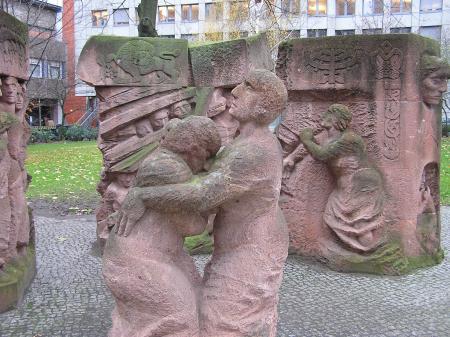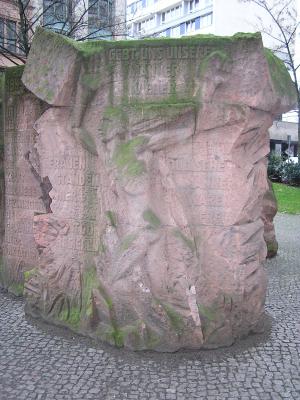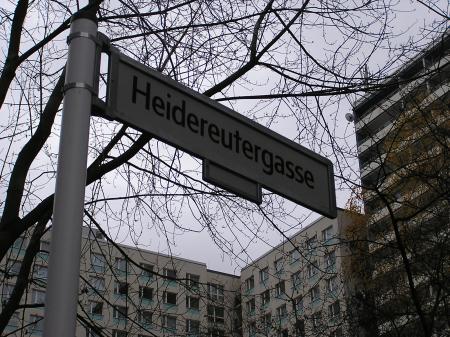Obj. ID: 42474
Modern Jewish Art Rosenstrasse Monument or Block of Women Monument in Berlin, Germany, 1995

Memorial name:
Block der Frauen or Denkmal Rosenstraße
Who is Commemorated?
Christian women who protested Nazi regime in February-March 1943
Description
The sculpture shows protesting and mourning women. The monument consists of three reddish sandstone blocks that form a semicircle around a couple lying in each other's arms. These two women, support and console one another, and stand opposite the arrested men. On the left, are huddled women and children. Two of the blocks have been placed to appear torn apart, but still as a unit. From one, a man emerges turning toward a woman, emerging from the other part. To the right is shown the release of the men and their reunion with their families. Framing all the figures and distributed across the stone blocks are a series of symbols, figures, and Hebrew letters carved in both high and low relief.
Hunzinger, though she is celebrating the bravery of German Christian women, filled her carved blocks with Jewish symbols. She also allows her work to express both collective anger on near mythic scale as well as more intimate personal grief. Her work calls up the drama of Greek tragedy in the massive blocks of soft red stone that spill across the plaza - much as the demonstrators themselves must have slowly and bravely come forth first as individuals and then en mass.
The composition of the scene is meant to distill into sculpture the emotional intensity and physical danger of the protesting women. The gestures and facial expressions of the figures portray both fear and determination. A man standing holding a broken violin represents the Nazi destruction of Jewish culture. A sculpted park bench refers to the restrictions imposed upon German Jews, who from early in the Nazi regime were forbidden to sit on public benches.
Inscription
The inscription in German on the rear of the monuments reads:
1943
Die Kraft des zivilen Ungehorsams
Die Kraft der Liebe
Bezwingen die Gewalt der Diktatur
Gebt uns unsere Männer wieder
Frauen standen hier
Tod besiegen
Jüdische Männer waren frei
Translation: The strength of civil disobedience / the vigor of love / overcomes the violence of dictatorship / Give us our men back / Women were standing here / defeating death / Jewish men were free
Commissioned by
Berlin Senate
sub-set tree:
H | Human Figure | Hand
H | Human Figure
H | Human Figure | Human head
J | Jewish man
M | Magen David
M | Menorah
M | Musical Instruments | Violin
W | Woman
L | Lion
T | Tree | Broken tree
T | Tree
V | Vase | Vase with flowers
V | Vase | Vase with fruits
A | Alphabet, Hebrew
O | Ornamentation: | Letter
|
When the monument was designed in the 1980s the history of the Rosenstrasse protest was little known. Artist Ingeborg Hunzinger had designed the sculptural monument, but it could not be erected in communist-era GDR. In 1989, Nathan Stolzfuss reported on the 1943 protests in the weekly newspaper Die Zeit and soon after, a project group was founded to promote a memorial on Rosenstraße. After German unification, the Berlin Senate enabled the erection of Hunzinger’s “Block of Women” ensemble of monumental sculptures in 1995. The site chosen is a small park adjacent to the site of the protests, and near the site of Berlin’s destroyed Old Synagogue.
Despite the power of the animated figural sculptures, little information was initially provided to inform viewers about the purpose of the work and the history of the commemorated events. This was changed in 2011, when a kiosk, replicating the appearance of an earlier “Litfaß column” (advertising column) was installed nearby on Rosenstrasse with historical information and photos that provide more information.
The Rosenstrasse protest of late February and early March 1943 was the rare instance where German civilians actively protested Nazi policies and actions. In ten years of Nazi rule, after the first brutal crackdowns in 1933 until 1943, such public resistance in Berlin and elsewhere was unknown. The women risked their lives to successfully gain the release of their Jewish husbands who had been rounded up for forced labor and likely deportation. Thus, many of the prisoners managed to survive the war. The reason for the release of the men, and what the effectiveness of the women’s protest tells us about the unfulfilled potential of protest in the Nazi era is the subject of much scholarly, political, and ethical debate.
The group of sculptures is located at the site of the former Jewish administrative building in which the Gestapo held the men captive, which was subsequently destroyed in the war. The actual building on Rosenstraße in which the men were held, was destroyed during an Allied bombing of Berlin at the end of the war.
Gruber, Samuel D. “Germany: Berlin's Dramatic Rosenstrasse Monument” Samuel Gruber’s Jewish Art & Monuments, March 8, 2017, https://samgrubersjewishartmonuments.blogspot.com/2017/03/germany-berlins-dramatic-rosenstrasse.html (accessed December 16, 2021)
Potter, Hilary, Bill Niven, and Chloe Paver, eds. "Rosenstraße: A Complex Site of German-Jewish Memory", in Memorialization in Germany since 1945. (New York Palgrave Macmillan, 2010), 214–223.
Potter, Hilary. Remembering Rosenstrasse: History, Memory and Identity in Contemporary Germany. (Oxford, Berlin, etc.: Peter Lang Limited, 2018)
Stoltzfus, Nathan. Resistance of the Heart: Intermarriage and the Rosenstrasse Protest in Nazi Germany. (New Brunswick, NJ: Rutgers University Press, 2001)
“Rosenstrasse Memorial,” Gedenkstättenportal zu Orten der Erinnerung in Europa (The Information Portal to European Sites of Remembrance) , https://www.memorialmuseums.org/eng/staettens/view/1410/Rosenstra%C3%9Fe-Memorial (accessed December 16, 2021)





















